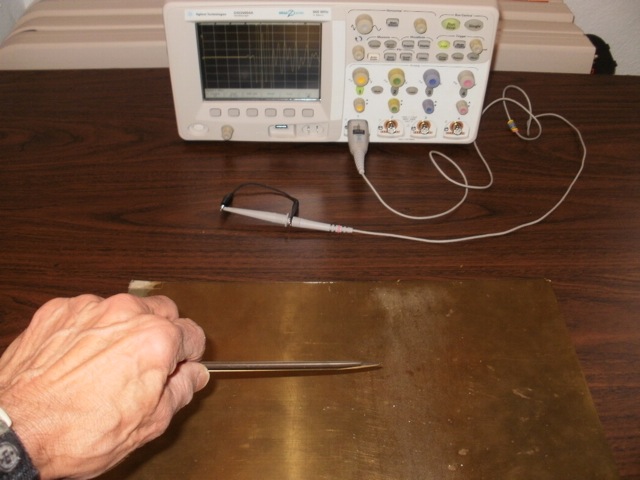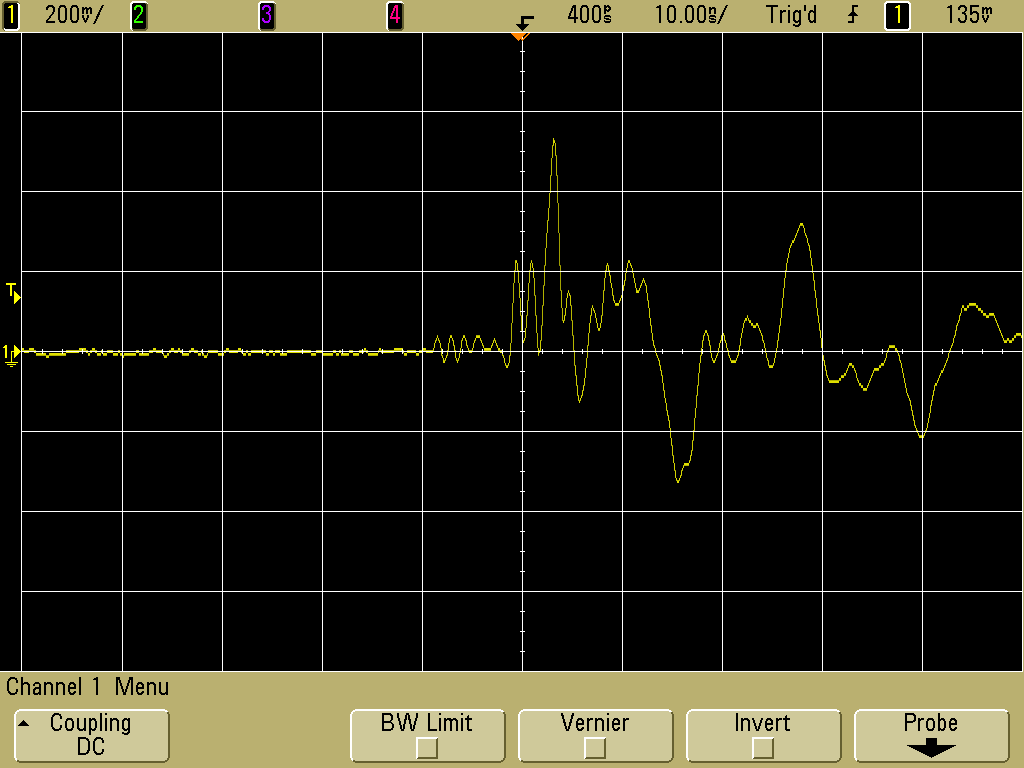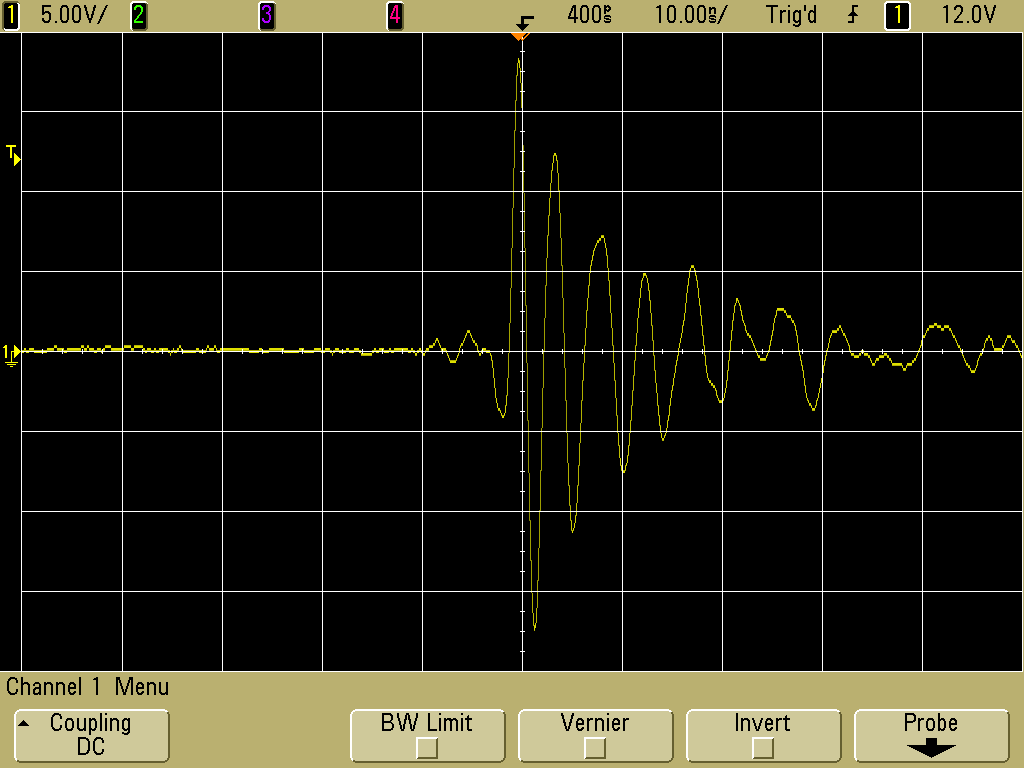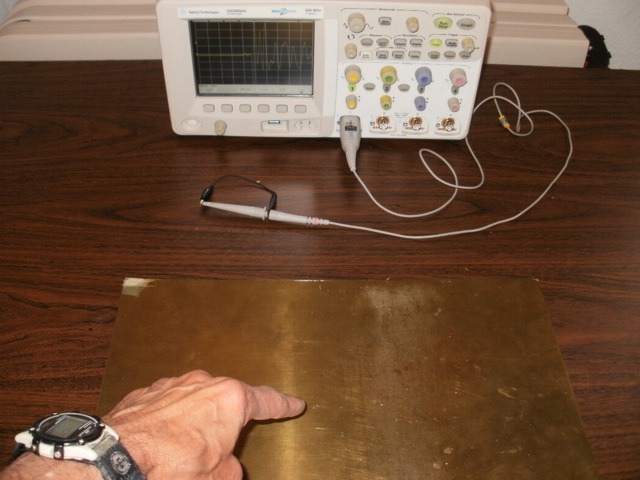Most system level ESD test standards,
like IEC61000-4-2, model an ESD event from a human hand holding a piece
of metal, such as a tool. This is called the
Human
Metal
Model, HMM. However, often equipment is subjected to ESD events directly from human skin, called the
Human
Body
Model,
HBM. Standards for solid state device handling often use the HBM model.
The series resistance for an HMM simulator is often 330 Ohms whereas
HBM simulators often are 1500 Ohms. However, the difference between
these two ESD events is much greater than the ratio of series
resistance in the simulators would suggest.
Figure 1 shows the test setup used to generate data for this Technical
Tidbit. A metal plate is used as the discharge target. After each
discharge, the plate is discharged to AC mains safety ground before the
next discharge. Next to the plate is an
Agilent 1163A, 1 GHz 500 Ohm resistive passive probe shorted by its ground lead and connected to an
Agilent
DSO5054A
oscilloscope. The shorted probe acts like a magnetics loop and picks up
the EMI radiation from the ESD event to the plate. The displayed
waveform on the scope is a measure of the intensity of the ESD event
and its ability to disrupt nearby electronic equipment.
Figure 2 shows a discharge applied by a screwdriver held in my hand. I
charged myself up by rubbing a foot on the carpet and then lifting it.
Developing a static charge this way in Boulder City, NV, my office and
lab location, is pretty easy. The relative humidity was bout 19% in the
room at the time of the experiment and even lower than that outside. As
I write this, the dew point outside is 7 degrees Fahrenheit and the
relative humidity is 7%.

Figure 2. Human Metal ESD From a Screwdriver
I took a number of discharges this way and the waveform shown in Figure
3 was typical. Note that peak voltage induced in the probe-ground lead
loop was about 18 Volts peak! No wonder that ESD can disrupt equipment
operation.
Figure 3. Voltage Induced in 1163A Shorted Scope Probe by HMM ESD
(Vertical Scale = 5 V/div, Horizontal Scale = 10 ns/div)
Figure 4 shows the same experiment but this time using just my finger.
Charge was developed the same way and a typical resulting waveform is
shown in Figure 5.
Figure 4. Human Body ESD From a Finger
Note that the peak voltage recorded is now only about 500 mV! That is
about 1/40th of the peak voltage in the probe loop resulting from the
hand metal discharge in Figure 3. In addition, the strong ringing at
about 250 MHz in Figure 3 is not present in Figure 5. Rather the
waveform in Figure 5 shows a waveform that looks more like a wave
reflecting back and forth on the scope cable.

Figure 5. Voltage Induced in 1163A Shorted Scope Probe by HBM ESD
(Vertical Scale = 200 mV/div, Horizontal Scale = 10 ns/div)
I have noticed that in locations with higher levels of humidity, where
the charge I can develop is much lower, the ratio between HMM and HBM
discharges is even greater than 40:1, often 100:1 or more.
In the following Technical Tidbits, I will explore the effect of
the size of the metal used and show actual current measurements.
Summary: There is
a large difference in the intensity of HMM and HBM ESD events. The
intensity of the radiated EMI from these two types of ESD events can
have a ratio of 40:1 or greater, an indication of the great difference
in intensity of these two types of ESD events. HMM is the type of event
usually applied to electronic systems during ESD testing. For equipment
that is only handled without metal involved, HMM is a significant over
test of the equipment tested.
Equipment used in this Technical Tidbit:
- Agilent 1163A, 1 GHz 500 Ohm resistive passive probe
- Agilent
DSO5054A





